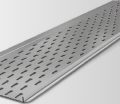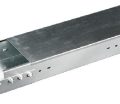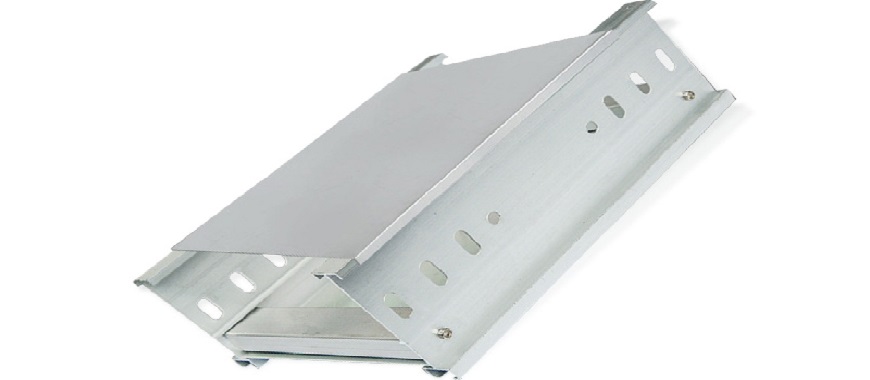
Epoxy cable tray systems are essential for efficient and durable cable management in industrial and commercial environments. Epoxy cable tray offers corrosion-resistant, fire-retardant, anti-aging cable support for industrial and fire‑protected installations. These systems are designed to support and protect cables while withstanding harsh conditions. The epoxy coating enhances the tray’s resistance to corrosion, moisture, and chemical exposure, making it suitable for demanding applications. With various types, such as perforated, ladder, and closed designs, epoxy cable trays cater to diverse project needs. They offer excellent load-bearing capacity and promote organized cable routing. Epoxy cable trays are widely used in industries like construction, energy, and telecommunications. Their lightweight yet robust construction ensures long-term reliability while minimizing maintenance requirements. These trays are an ideal choice for projects requiring both durability and performance.
What Are Epoxy Cable Trays
Epoxy cable trays are fiber‑reinforced plastic support systems with glass fibers embedded in an epoxy resin matrix, offering superior corrosion resistance and electrical insulation compared to metallic trays. Ideal for industrial and offshore environments, these trays protect and organize power, control, and communication cable tray systems against moisture, chemicals, and extreme temperatures. With durable epoxy coatings, they enable reliable long‑term performance in chemical plants, data centers, and telecommunications installations. Multiple configurations ensure low‑maintenance solutions for modern infrastructure projects requiring secure cable management.
Key characteristics
- Corrosion resistance: The epoxy matrix protects the glass fibers from chemical attack, making these trays ideal for highly corrosive environments (e.g., chemical plants, wastewater treatment facilities, offshore platforms).
- High strength‑to‑weight ratio: Glass‑fiber reinforcement lends excellent load‑bearing capacity while keeping the tray lightweight and easy to handle.
- Electrical insulation: Non‑conductive materials prevent unintended grounding paths and reduce the need for additional insulators when routing power or communication cables.
- Low thermal expansion: The composite structure remains dimensionally stable across wide temperature ranges, reducing stresses at joints and connections.
- UV and flame resistance: Many epoxy cable trays are formulated with UV inhibitors and meet flame‑retardant standards (e.g., UL 94 V‑0), ensuring longevity in outdoor and safety‑critical installations.
- Passive fire protection: The epoxy/glass‑fiber composite inherently resists heat transfer and structural degradation under fire exposure, providing a built‑in passive fire barrier that helps maintain cable support integrity and meet fire‑safety codes without additional intumescent coatings.
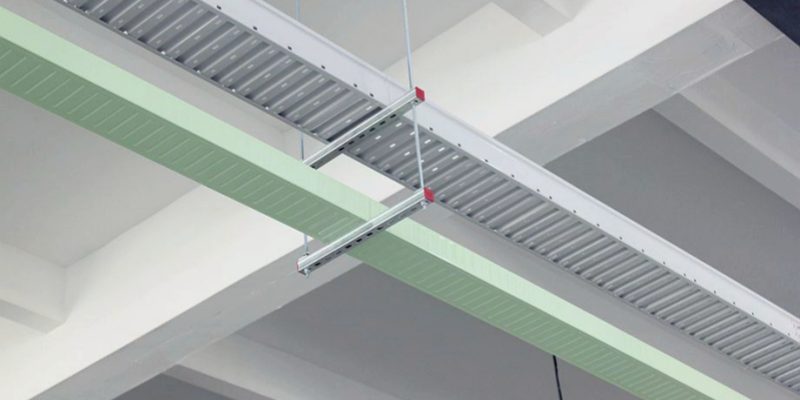
Benefits of Using Concrete Cable Tray Systems
Key Benefits of Using Epoxy Cable Trays
Epoxy cable trays combine corrosion‑resistant epoxy resin with fiber‑reinforced plastic to offer superior durability, a high strength‑to‑weight ratio, and a sleek, low‑maintenance finish. Ideal for industrial, offshore, and commercial installations, these trays enhance reliability, simplify installation, and reduce lifecycle costs.
Enhanced Longevity in Harsh Environments
Epoxy cable trays are engineered to withstand corrosive chemicals, high humidity, and significant temperature fluctuations without degrading or losing structural integrity. The robust FRP construction combined with the protective epoxy resin ensures resistance to rust, pitting, and UV exposure, extending service life beyond that of traditional metal trays. This durability minimizes the need for frequent repairs or replacements, reducing downtime and lifecycle costs for facilities operating in demanding industrial or offshore environments.
Lightweight Yet Strong Material Properties
Despite their formidable strength, epoxy cable trays maintain a remarkably low profile in weight, easing handling during transport and streamlining installation processes. The high strength‑to‑weight ratio offered by glass fiber reinforcement within an epoxy matrix allows for larger spans and fewer support points without sacrificing load‑bearing capacity. This reduction in structural obstruction also simplifies design requirements, lowers shipping costs, and accelerates project timelines, making epoxy trays an efficient choice for cable management.
Aesthetic Appeal and Low Maintenance Needs
The seamless epoxy coating on fiber‑reinforced plastic trays creates a smooth, uniform surface that repels dust, oils, and grime, helping maintain a clean, professional environment. Unlike uncoated metal trays that corrode and collect debris, these trays require minimal cleaning and inspection, reducing labor costs and downtime. Their sleek appearance complements modern facility aesthetics, while the corrosion‑proof finish preserves both form and function, ensuring cable pathways remain organized and visually unobtrusive.
Types of Epoxy Cable Trays
Epoxy cable trays come in a range of styles—perforated, aluminum, closed, stainless steel ladder, and ladder type—each engineered to deliver specific performance benefits. From enhanced ventilation and corrosion resistance to complete environmental protection and high load capacity, selecting the right design ensures optimal cable management across various industries.
Perforated Cable Tray Systems
Perforated epoxy cable trays, a ventilated cable tray variant, feature evenly spaced openings that promote efficient ventilation and heat dissipation, making them ideal for power and data cable management in environments prone to high thermal loads. Their design supports safe operation by preventing overheating and facilitating straightforward routing and maintenance in cable tray application settings such as data centers and industrial power distribution. These trays strike a balance between structural support and airflow, ensuring reliable performance where temperature control is critical.
Aluminium Cable Tray Systems
Aluminium epoxy cable trays combine lightweight aluminum construction with a durable epoxy coating to deliver enhanced corrosion resistance, particularly suited to outdoor, coastal, and humid environments. Available in widths ranging from narrow runs for tight spaces to wide formats for large cable bundles, these trays accommodate diverse project scales. Their smooth, coated surface simplifies cleaning and inspection, while the aluminum core ensures ease of handling and installation without compromising load‑bearing capacity.
Closed Cable Tray Systems
Closed epoxy cable trays offer a fully enclosed solution that shields cables from moisture, dust, chemical exposure, and other environmental hazards. The seamless epoxy coating forms a watertight barrier, preventing ingress of corrosive agents and moisture—ideal for cleanrooms, laboratories, and hazardous facilities. By providing complete protection and maintaining a tidy appearance, closed trays reduce maintenance demands and extend cable life in settings where contamination control and reliability are paramount.
Stainless Steel Ladder Cable Tray
Stainless steel epoxy cable trays deliver exceptional strength and load‑bearing capacity for heavy‑duty installations, while their epoxy resin matrix ensures superior corrosion and chemical resistance. Engineered to withstand extreme weather and aggressive environments, these trays are favored in oil and gas facilities, offshore platforms, and outdoor electrical infrastructures. Their ladder‑style construction combines rigid support with durable finish, guaranteeing uninterrupted performance even under continuous mechanical stress and exposure to harsh elements.
Ladder Type Tray Systems
Ladder epoxy cable trays feature spaced rungs that maximize airflow and heat dissipation, making them the preferred choice for high‑capacity cable runs and systems where thermal management is essential. Optimized rung spacing and sturdy support rails accommodate various cable diameters and weights, ensuring even load distribution. Enhanced with a corrosion‑resistant epoxy FRP coating—akin to that used in epoxy FRP pipe—these trays offer long‑term durability and low maintenance in demanding industrial, telecommunications, and infrastructure applications.
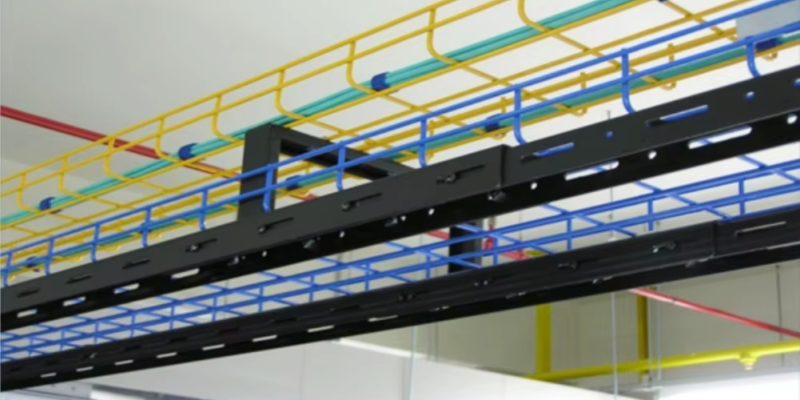
Linear Heat Detector for Cable Tray Fire Safety Solutions
Factors to Consider When Choosing Epoxy Cable Tray
When specifying an epoxy cable tray system, key considerations include environmental resistance to corrosion, load capacity and span requirements, installation and support spacing, and thermal management. Balancing these factors ensures a durable, compliant solution that performs reliably under current demands and accommodates future cable expansions.
Environmental Conditions and Material Compatibility
Evaluate the specific environmental challenges your installation will face—humidity, salt spray, extreme temperatures, UV exposure, and chemical contact. Epoxy cable trays’ FRP construction and resin matrix resist corrosion, pitting, and degradation, ensuring long‑term integrity. Confirm compatibility with any aggressive solvents, acids, or alkalis present, and select UV‑stabilized coatings for outdoor applications to prevent brittleness and discoloration over time.
Load-Bearing Requirements for Various Cable Weights
Determine the total weight, bundle size, and density of power, control, and communication cables to be supported. Epoxy cable trays offer diverse profiles—from lightweight single‑rack designs to heavy‑duty ladder configurations—each rated for specific load capacities and span lengths. Account for dynamic forces such as vibration, wind loading, and potential future cable additions when specifying support intervals and tray depth for safe, compliant installation.
Installation and Support Spacing
Consider ease of handling, transportation, and onsite assembly when choosing tray type and dimensions. Epoxy FRP trays are lighter than metal, reducing labor and equipment needs. Review manufacturer recommendations for support spacing based on tray width and load to minimize deflection. Properly spaced hangers or wall brackets enhance structural performance, simplify alignment, and help maintain consistent installation quality across long runs.
Thermal Management and Ventilation
In high‑heat or densely cabled environments, effective heat dissipation prevents derating and extends cable life. Ventilated or perforated epoxy trays allow ambient air circulation, while ladder‑type designs promote natural convection along cable bundles. Assess whether passive ventilation suffices or if forced-air cooling is required. Choose tray profiles that balance structural support with open area to optimize thermal performance and reduce fire risk.
Installation and Maintenance of Epoxy Cable Trays
Proper installation and regular maintenance are essential for ensuring the long-term performance of epoxy cable tray systems. These steps help enhance durability, reduce risks, and maintain optimal functionality for cable management in various industrial and commercial environments.
Installation Guidelines for Epoxy Cable Trays
Tips for Secure Mounting and Alignment
Mount epoxy cable trays on stable, level surfaces to maintain precise alignment throughout the run. Secure each tray section to supports using high‑quality anchors and GangLong Fiberglass brackets, ensuring connections resist vibration and mechanical stress. Evenly space hangers or wall brackets per manufacturer guidelines to minimize deflection, prevent sagging under load, and facilitate organized cable routing during installation and future maintenance.
Ensuring Proper Bonding and Grounding
Implement robust electrical bonding and grounding for epoxy cable tray systems to safeguard against faults. Connect bonding conductors between tray sections and to facility ground using corrosion‑resistant lugs and clamps designed for FRP components. Verify low‑impedance paths by measuring continuity across spans. Adhere to relevant electrical codes and standards, utilizing manufacturer‑approved bonding accessories to simplify installation and ensure long‑term safety.
Managing Thermal Expansion and Movement
Allow for thermal expansion and contraction of epoxy cable trays by incorporating sized expansion joints and supports at flanged connections. Position joints at recommended intervals based on tray length and anticipated temperature variations. Use flexible connectors to prevent stress transfer. Clearly mark and document joint locations to facilitate future inspections, ensuring system integrity and preventing structural distortion during thermal cycling.
Maintenance Practices to Maximize Tray Lifespan
Cleaning and Inspection Schedules for Epoxy Trays
Schedule routine cleaning to remove dust, debris, and contaminants from epoxy cable trays at least quarterly or according to site conditions. Use manufacturer‑approved cleaning kits and non‑abrasive tools to avoid surface damage. During inspections, examine trays for cracks, delamination, loose fasteners, and corrosion at joints. Document findings and perform corrective actions promptly to prevent issues from escalating and ensure reliable operation.
Preventative Measures to Avoid Damage or Wear
Avoid overloading trays beyond their rated capacity by verifying cable weights and bundling estimates before installation. Install impact guards or bollards in high‑traffic zones to protect against mechanical damage, and apply UV‑resistant covers or sleeves where sunlight exposure is significant. Secure loose cables and maintain proper bend radii to minimize stress. Regularly review load distribution and adjust support locations as needed.
Inspecting Fasteners and Support Hardware
Inspect fasteners, brackets, and support hardware every six months to ensure secure connections. Tighten any loose bolts and replace corroded or damaged anchors with approved stainless‑steel or FRP‑compatible components. Verify bracket alignment and adjust as necessary to maintain tray level. Keeping hardware in optimal condition prevents structural sagging and reduces vibration‑induced wear, extending the service life of the cable tray system.
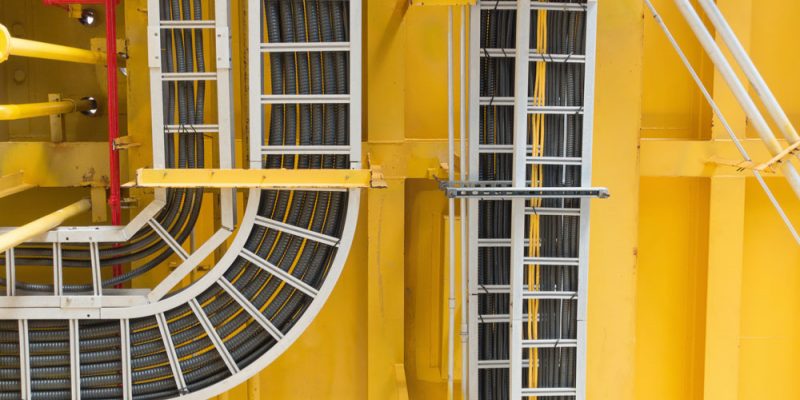
Advantages of Using a One Touch Cable Tray
Emerging Trends in Epoxy Cable Tray Design
Lightweight Materials with Epoxy Coatings
Combining aluminum or advanced composite substrates with high-performance epoxy coatings delivers outstanding strength‑to‑weight ratios and exceptional corrosion protection in harsh environments. These lightweight hybrid cable trays simplify handling, transportation, and installation by reducing system weight, lowering labor and equipment requirements. They maintain robust load capacities and span capabilities, meet stringent industry standards, and offer long‑term performance in demanding infrastructure projects.
Sustainability and Recyclability
Eco-conscious formulations and recycling strategies are emerging in epoxy cable tray design and manufacturing. Leading suppliers offer bio‑resin formulations and fully recyclable FRP components that minimize production energy use, reduce landfill waste, and lower carbon footprints. These sustainable systems deliver equivalent mechanical strength, chemical resistance, and long‑term reliability, supporting circular economy principles while maintaining overall performance in demanding infrastructure projects.
Enhanced Corrosion Resistance & Environmental Adaptability
Next‑generation epoxy resin matrices incorporate specialized fillers and optimized cross‑link densities to resist aggressive chemicals, salt spray, ultraviolet radiation, and extreme temperatures. These advanced coatings provide superior environmental adaptability in coastal, industrial, and chemical facilities, extending service life compared to traditional materials. Enhanced barrier properties prevent pitting and degradation, maintain structural integrity, and reduce maintenance intervals in harsh, corrosive environments.
Advanced Application Techniques
Innovations in high-performance epoxy coating application include powder‑based deposition, ultraviolet and induction curing, and plasma pre‑treatment to enhance adhesion on diverse substrates. These advanced techniques produce uniformly bonded, smooth, abrasion‑resistant coatings that outperform wet‑spray methods. They optimize manufacturing efficiency, reduce solvent emissions, and improve quality control across traditional tray profiles, powder coated raceway, and durable support structures for reliable long‑term performance.
FAQs about Epoxy Cable Tray
Yes, cable trays must be bonded to ensure electrical safety and compliance with industry standards. Bonding creates a continuous electrical path to prevent potential hazards caused by fault currents. In epoxy cable tray systems, proper bonding reduces the risk of electric shock and minimizes fire risks. It is particularly important in installations where electrical grounding is required for regulatory compliance. Proper bonding techniques involve connecting the tray sections with grounding conductors and ensuring these connections are secure and conductive. This process helps maintain the overall integrity of the cable management system. Consulting installation guidelines for epoxy cable trays ensures that all bonding requirements are met effectively.
The three main types of cable trays are ladder, perforated, and solid-bottom trays. Each type serves specific applications based on cable management needs. Ladder trays consist of side rails and spaced rungs, providing excellent ventilation and heat dissipation for high-capacity cable systems. Perforated trays have small openings along their base, which allow airflow and offer support for medium-duty cables. Solid-bottom trays offer complete cable enclosure, protecting cables from dust, moisture, and external damage. Epoxy cable trays are available in all these configurations, making them suitable for diverse industries and environmental conditions. Selecting the right tray type depends on factors like load requirements, installation environment, and project specifications.
Cable trays can be a cost-effective option for cable management, depending on the project scope and requirements. Unlike conduits, epoxy cable tray systems simplify installation by eliminating the need for complex bending or fittings. They also provide easy access for cable additions or modifications, reducing labor costs over time. The lightweight and durable design of epoxy cable trays minimizes transportation and maintenance expenses. While initial costs may vary, cable trays often prove more economical in large-scale installations where efficiency and flexibility are prioritized. Consulting project-specific needs helps determine whether cable trays are a more suitable and affordable choice than conduit systems.
Cable trays are constructed from materials like aluminum, steel, and fiberglass, often enhanced with protective coatings. Epoxy cable trays feature a layer of epoxy resin, which provides superior resistance to corrosion, chemicals, and environmental wear. Steel trays offer high strength and durability for heavy-duty applications, while aluminum trays are lightweight and resistant to rust, making them ideal for outdoor installations. Fiberglass trays are known for their non-conductive properties and resistance to fire and chemical exposure. The choice of material depends on the specific demands of the environment and the project. Epoxy coatings on these materials enhance their performance, ensuring long-term reliability and protection in challenging conditions.

As the editor of GangLong Fiberglass, I have years of experience and in-depth research, focusing on cable tray products, fiberglass solutions, and grille systems. I incorporate years of industry insights and practical experience into every content, committed to promoting the progress of the industry. At GangLong Fiberglass, my commitment is reflected in every product, from innovative cable trays to durable fiberglass solutions and sturdy grille systems. As an authoritative voice in the industry, my goal is to provide valuable information to professionals and businesses and promote forward-looking solutions.

